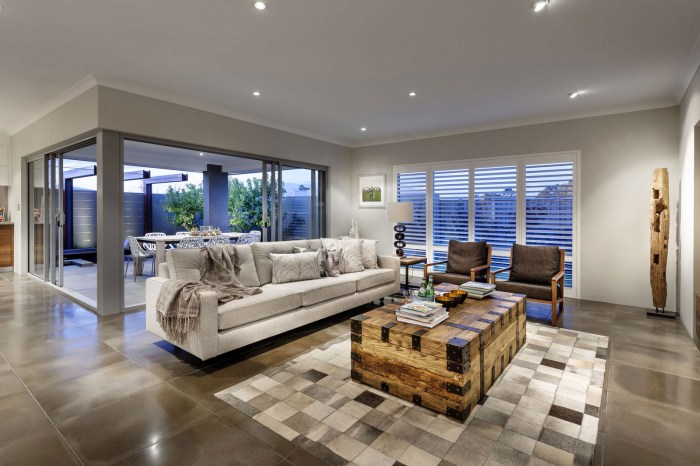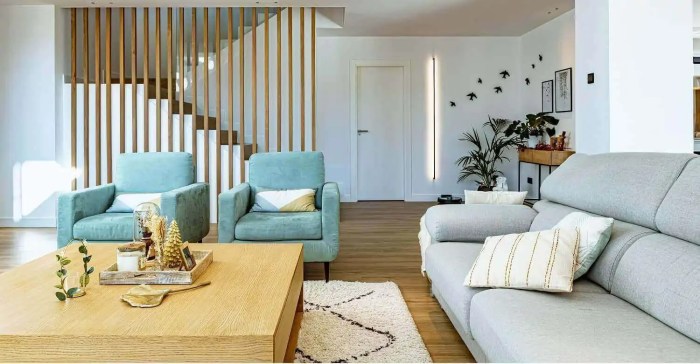Exploring Interiors Home: A Comprehensive Guide to Interior Design
Interiors home sets the stage for this enthralling narrative, offering readers a glimpse into a story that is rich in detail with casual but standard language style and brimming with originality from the outset.
As we delve into the world of interior design, we uncover the significance of well-thought-out interiors in transforming a house into a home. From color schemes to furniture choices, every element plays a vital role in shaping the ambiance of a living space.
Join us on this journey as we explore the nuances of interiors home and discover how it can truly elevate your living experience.
Importance of Interiors in a Home

Interiors play a crucial role in shaping the overall look and feel of a home. The design choices made for the interiors can significantly impact the aesthetics, mood, and functionality of a living space.
Well-designed interiors have the power to enhance mood and productivity. A thoughtfully curated space with the right colors, lighting, and furniture can create a welcoming and comfortable environment that promotes relaxation and focus.
Popular Interior Design Styles and Their Influence
- Modern: Characterized by clean lines, minimalism, and a focus on open spaces, modern interior design creates a sleek and contemporary atmosphere.
- Traditional: Inspired by classic design elements and rich textures, traditional interiors exude elegance and timeless charm.
- Scandinavian: Known for its simplicity, functionality, and use of natural materials, Scandinavian design fosters a sense of calm and coziness.
- Industrial: Featuring raw and unfinished elements like exposed brick and metal accents, industrial design adds an edgy and urban vibe to a home.
- Bohemian: Embracing a free-spirited and eclectic approach, bohemian interiors are vibrant, colorful, and full of personality.
Elements of Interior Design

When it comes to interior design, several key elements play a crucial role in transforming a space into a beautiful and functional home. These elements include color, lighting, furniture, and decor, each contributing uniquely to the overall look and feel of a living space.
Color
Color is one of the most powerful tools in interior design, capable of setting the mood, creating visual interest, and defining the personality of a room. Warm colors like red, orange, and yellow can energize a space, while cool colors like blue, green, and purple can promote relaxation.
Neutral colors like white, beige, and gray provide a versatile backdrop that can be easily paired with other hues.
Lighting
Lighting is essential for both functionality and aesthetics in a home. Natural light can make a space feel open and inviting, while artificial lighting fixtures like chandeliers, lamps, and sconces can add depth and drama to a room. Proper lighting can also highlight architectural features and artwork, enhancing the overall design.
Furniture
The furniture you choose for a room not only serves a practical purpose but also contributes to the style and theme of the space. The size, shape, and material of furniture pieces can impact the flow and functionality of a room.
Mixing different furniture styles and incorporating pieces with varying textures can create a dynamic and visually appealing design.
Decor
Decor elements such as rugs, curtains, artwork, and accessories add the finishing touches to a room's design. These decorative accents can bring color, pattern, and personality to a space, tying together the overall aesthetic. By carefully selecting and arranging decor items, you can enhance the style and ambiance of your home.
Trends in Home Interiors
When it comes to interior design, trends are constantly evolving, shaping the way we decorate our homes. Let's take a look at some of the current trends influencing home interiors.
Minimalist Design
Minimalist design has been a popular trend in recent years, characterized by clean lines, simple color palettes, and a focus on functionality. This style emphasizes the idea that less is more, creating a sense of calm and simplicity in the home.
Bohemian Style
On the other end of the spectrum, bohemian style embraces a more eclectic and free-spirited approach to design. This trend incorporates bold colors, patterns, and a mix of textures to create a vibrant and cozy living space. It often includes elements from different cultures and eras, adding a sense of personality and warmth to the home.
Scandinavian Influence
Scandinavian design continues to be a popular choice for many homeowners, known for its emphasis on light, simplicity, and functionality. This style often features clean lines, neutral colors, and a minimalist approach to furniture and decor. The use of natural materials and ample natural light are key elements of Scandinavian interiors, creating a sense of warmth and tranquility.
Traditional vs. Modern
While traditional interior design focuses on ornate details, rich colors, and classic furniture pieces, modern trends lean towards simplicity, minimalism, and a more streamlined aesthetic. The shift towards modern design reflects a desire for cleaner, more open spaces that are both functional and visually appealing.
Technology in Interior Design
Advancements in technology have also greatly influenced interior design choices in homes. From smart home devices to virtual reality tools, technology is transforming the way we design and interact with our living spaces. Homeowners can now experiment with different layouts, colors, and styles virtually before making any physical changes, making the design process more efficient and personalized.
Tips for Decorating Home Interiors
Decorating your home interiors is an exciting process that allows you to showcase your personal style and create a space that reflects your personality. Here are some tips to help you decorate your home interiors effectively.
Selecting Color Schemes for Different Rooms
Choosing the right color scheme for each room can significantly impact the overall look and feel of your home. Here are some tips to help you select the perfect color schemes:
- Consider the function of the room: Choose colors that complement the purpose of the room. For example, calming hues like blues and greens work well in bedrooms, while vibrant colors may be more suitable for living areas.
- Use a color wheel: Understanding color theory can help you create harmonious color schemes. Complementary colors (opposite on the color wheel) can create a striking contrast, while analogous colors (next to each other) offer a more subtle look.
- Test samples: Before committing to a color, test paint samples on the walls to see how they look in different lighting conditions throughout the day.
Optimizing Space in Small Interiors
Living in a small space doesn't mean sacrificing style and functionality. Here are some tips to help you optimize space in small interiors:
- Choose multipurpose furniture: Opt for furniture pieces that serve more than one function, such as a storage ottoman or a sofa bed.
- Utilize vertical space: Install shelves or wall-mounted storage to maximize storage space without cluttering the floor.
- Use mirrors: Mirrors can create the illusion of a larger space by reflecting light and making the room feel more open.
Mixing Textures and Patterns for a Visually Appealing Interior
Adding texture and patterns to your interiors can bring depth and visual interest to your space. Here are some tips on mixing textures and patterns effectively:
- Start with a neutral base: Use neutral colors as a foundation and add pops of color and patterns through pillows, rugs, and curtains.
- Mix different textures: Combine smooth surfaces with rough textures to create a dynamic and inviting space.
- Balance bold patterns: If you're using bold patterns, balance them out with solid colors to prevent overwhelming the space.
Final Conclusion
In conclusion, interiors home is not just about aesthetics; it's about creating a sanctuary that reflects your personality and enhances your quality of life. By understanding the key elements, current trends, and expert tips in interior design, you can unlock the full potential of your living space.
So, let your creativity soar and make your home a true reflection of your style and taste.
Detailed FAQs
How important is lighting in interior design?
Lighting plays a crucial role in setting the mood and highlighting key elements of a space. It can make a room feel cozy, spacious, or vibrant, depending on the type and placement of lights.
What are some popular interior design styles?
Popular interior design styles include minimalist, bohemian, Scandinavian, industrial, and mid-century modern. Each style has its unique characteristics and influences on home atmosphere.
How can I optimize space in small interiors?
To optimize space in small interiors, consider using multifunctional furniture, utilizing vertical storage solutions, and keeping clutter to a minimum. Mirrors and light colors can also create an illusion of more space.
Why is texture important in interior design?
Texture adds depth and visual interest to a space, making it more inviting and dynamic. Mixing different textures like smooth, rough, soft, and shiny can create a visually appealing and balanced interior.




